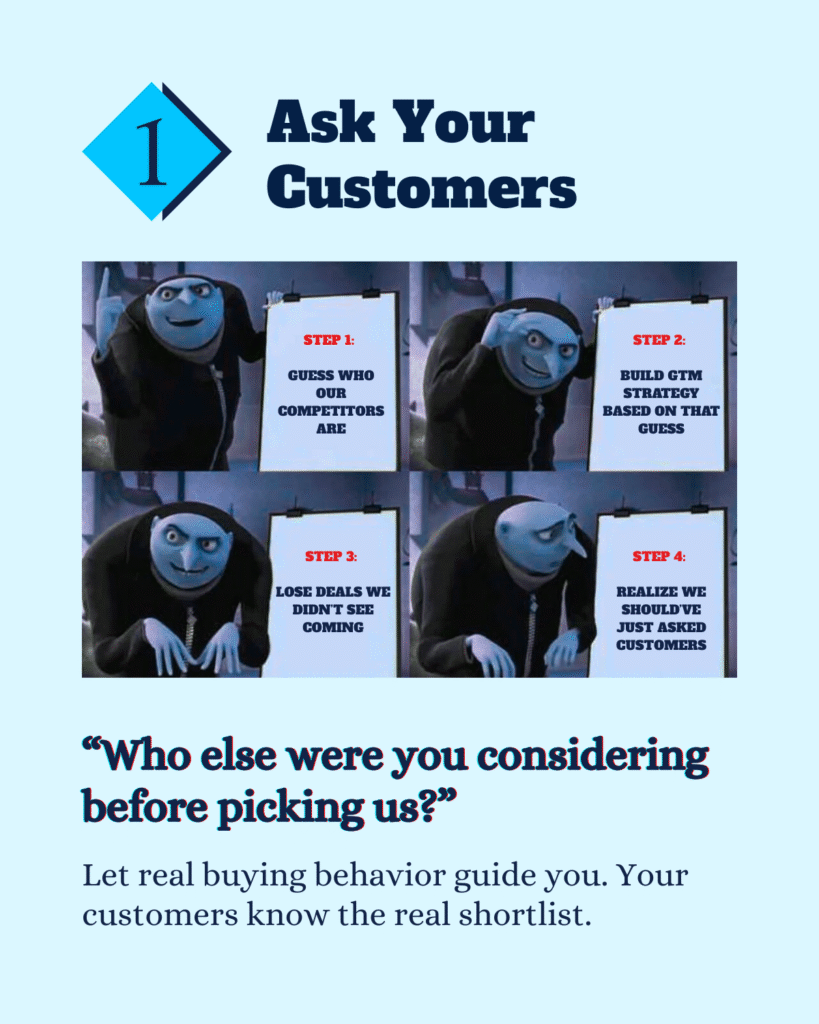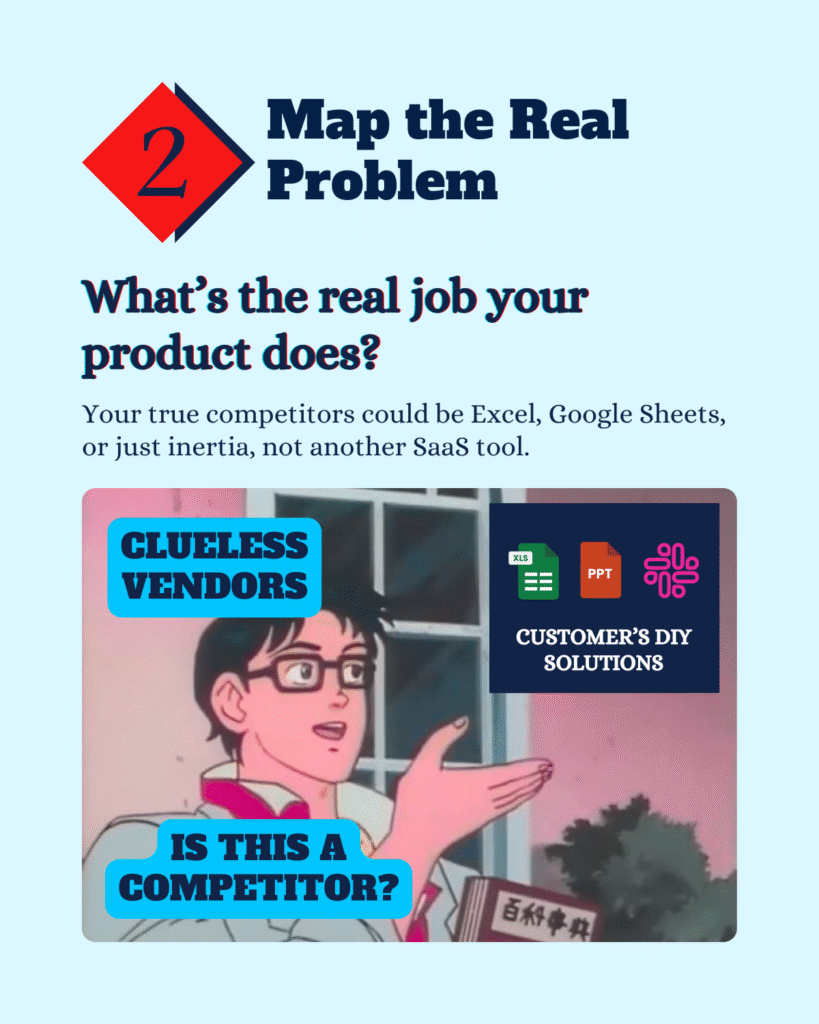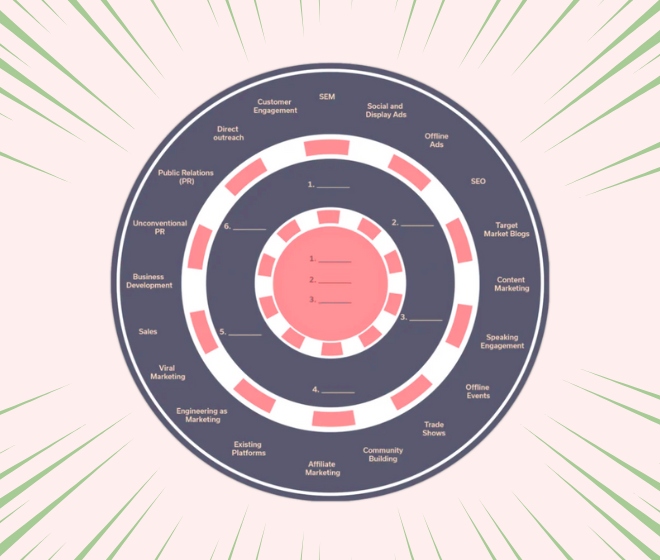You think you know your competition, but you could be wrong. Every founder I’ve worked with starts with a simple guess: “Our competitors are X, Y, and Z.” We build our entire GTM around that guess, only to lose deals we never saw coming. It’s a rookie mistake, and it’s a trap I’ve fallen into myself. Your real competitive analysis isn’t about listing your rivals. It’s about uncovering the truth about your market, and you can only do that by asking the right questions. Your real competition isn’t always another SaaS tool—it could be a spreadsheet or just the decision to do nothing at all.
Key Takeaways
- Stop Guessing: Don’t assume you know your competitors. Instead, let your customers’ real buying behavior guide you by asking them who else they considered.
- Map the Real Problem: Your true competition might not be another SaaS tool. It could be a simple DIY solution like Excel, Google Sheets, or the customer’s decision to do nothing at all.
- Learn from Lost Deals: Analyze why you are losing deals. The patterns you find in lost deals reveal your top competition and provide valuable feedback on what your product is missing.
- Listen to the Market: Watch social media and forums like Reddit and Quora to hear what your ideal customers are saying about the tools and workarounds they’re discussing.
- Fix GTM Misalignment: Misalignment is easy for your customers to spot. By aligning your marketing, sales, and product teams, you can fix the gaps and start seeing results.
DOWNLOAD THE FOUNDER’S PLAYBOOK ➜
1. Ask Your Customers
This is the most critical and overlooked step. Forget what you think you know. The only people who know your true competition are your customers.
The Mistake: Guessing who your competitors are, building a GTM strategy around that guess, and then getting blindsided by a lost deal. The Fix: Ask every single customer one simple question: “Who else were you considering before picking us?” Listen to what they say. Let their real buying behavior be your guide. Their shortlist is your real competitive landscape.

2. Map the Real Problem
Your product solves a problem, but what is the real “job” it’s hired to do? Your competitor isn’t just another company; it’s whatever the customer is currently using to get that job done.
The Mistake: Thinking your competitor is only another tool like yours.
The Fix: Your true competition could be a messy Excel sheet, a manual process, or the customer’s own DIY solution. They might even just decide that the problem isn’t painful enough to fix—which is called inertia. Until you identify the real problem you solve, you’ll be fighting the wrong battle.

3. Look at Lost Deals
You learn more from your losses than your wins. Every lost deal is a data point, a clue, and a chance to get smarter.
The Mistake: Ignoring lost deals or chalking them up to “they just weren’t a good fit.” The Fix: Don’t be afraid to check who you’re losing to and, more importantly, why. Patterns here will reveal your top competition. Talk to prospects who chose another solution and ask them what your product was missing. This feedback is a goldmine for your GTM strategy.

4. Spy on SEO and GEO Traffic
This is the digital reconnaissance phase. Use tools to see who is actually fighting for the same eyeballs you are.
The Mistake: Only focusing on the competitors you know, while others are stealing your target audience. The Fix: Look at who is bidding on your core keywords and ranking for the terms your customers are searching for. Use tools like Ahrefs or SEMrush to find out who’s advertising against you. This will show you who’s investing in the same customer mindshare you are.

5. Watch Social & Forums
Your Ideal Customer Profiles (ICPs) are talking—you just have to listen in.
The Mistake: Thinking of competitive analysis as a one-time exercise. The Fix: Keep a constant pulse on what people are saying. Your ICPs are discussing their problems and workarounds on platforms like Reddit, Slack, and Quora. These conversations will reveal what tools they’re using, what they love, and what they hate—all of which is crucial intel for your GTM.

Don’t let your GTM get held back by misalignment. A structured GTM is the key to turning your hustle into scalable growth.



